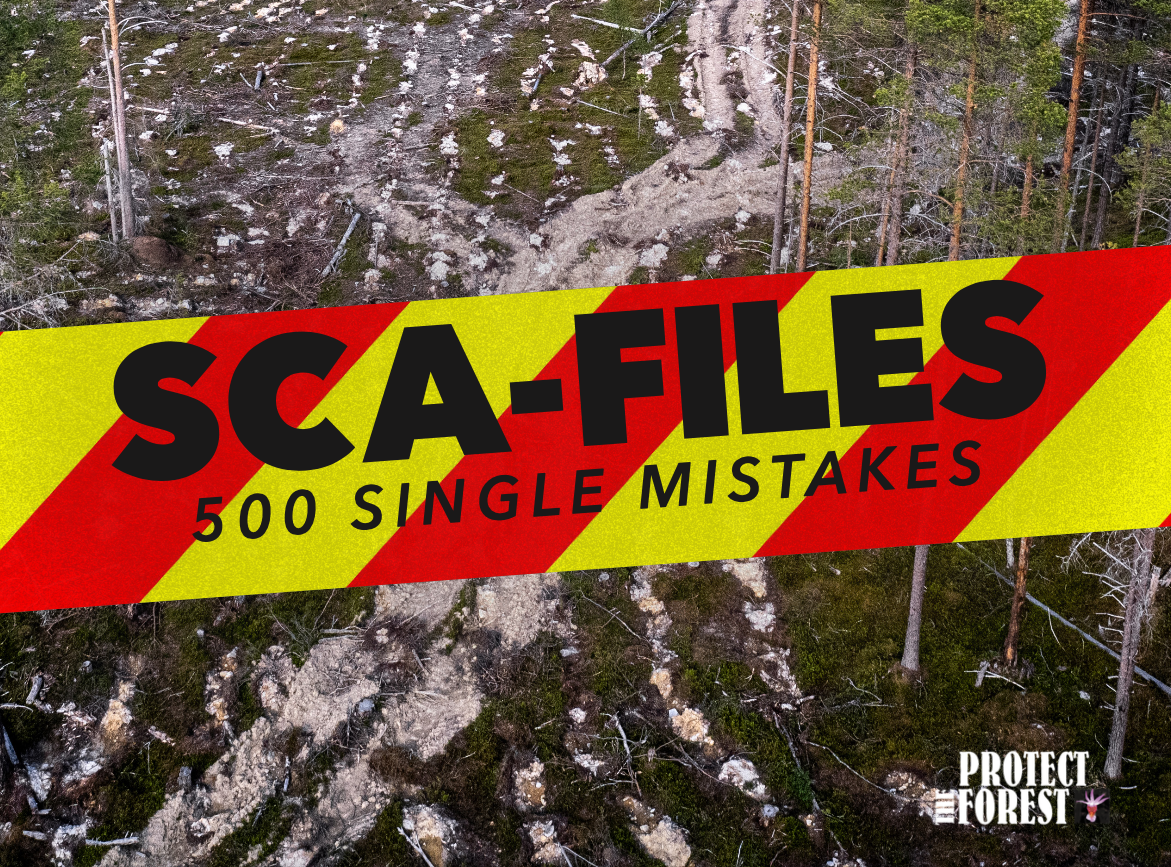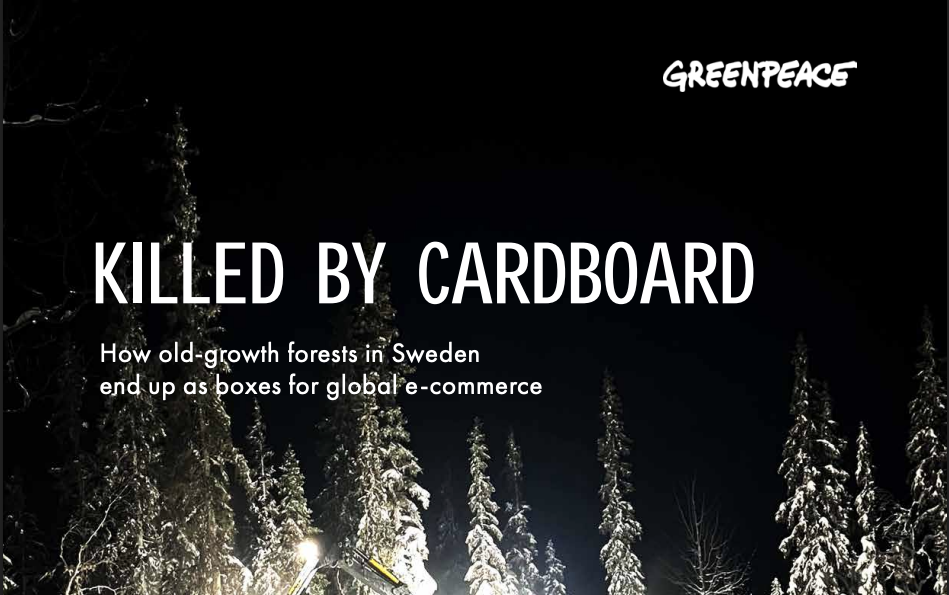Background
Background
Sweden’s natural forests are being destroyed
Sweden’s old-growth and continuity forests – some of Europe’s last unprotected natural forest ecosystems – are disappearing at an alarming rate. Every year tens of thousands of hectares of such forests are notified to be clear cut.
The main culprit behind this disastrous development is SCA, Europe’s largest private forest owner. Although the company has been FSC-certified for more than 20 years, it has repeatedly and systematically clear cut forests with conservation values – home to protected and red-listed species.
• What is a continuity forest? ▼
A continuity forest is a forest that has never been clear-cut. These precious forests have a unique biodiversity and long continuity, and are, if not managed with modern forestry, self-regulating complex dynamic habitats. Forests that have not been clear-cut in the past are finite critical habitats.
Continuity forest is defined by the Swedish Forest Agency (2011) as: “A forest that has natural values whose occurrence is explained by the fact that for a long time there have been suitable forest habitats and substrates in this particular forest or in its vicinity“.
Many species are associated with continuity forests, and these forests have a unique biological diversity. The Swedish Species Information Center at the Swedish University of Agricultural Sciences states that: “Lack of continuity forests, i.e. forests that have never been clear-cut, is one of the main reasons why forest-dwelling species are listed on the Swedish Red List.” and that: “In order to reverse the trend of declining populations, unprotected forest environments, with habitats for red-listed species, need to be preserved in the long term throughout the country.” For more info, visit SLU website.
500 “single mistakes”

SCA claims that these logging operations are “individual mistakes”, but a report from Protect the Forest shows that at least 500 cases of forests with documented conservation values have been logged or are planned to be logged. This clearly reveals a systematic pattern rather than isolated incidents. Despite the high number of examples, this is just the tip of the iceberg. Due to limited resources, conservationists only have the opportunity to visit a fraction of all the clear-cuts that SCA plans every year.
Despite years of heavy criticism of their forestry’s negative effects on biodiversity, climate and indigenous reindeer herding, SCA has not budged. Instead they have threatened to drop their environmental certification FSC – no doubt in order to log even more aggressively in conservation value forests and on indigenous lands.
A product carrying the FSC-label is in no way a guarantee that it comes from sustainably managed forests. Most environmental organisations have left (or never joined) the Swedish FSC due to weak regulations and the certifications inability to address these disastrous shortcomings.
Killed by Cardboard
This Greenpeace report shows how old-growth forests in Sweden end up as boxes for global e-commerce.
The report’s investigations links Nestlé and DS Smith, among others, to companies that are logging forests with conservation values in Sweden.

Over the course of a year, Greenpeace Sweden carried out field investigations in old-growth forests that have been destroyed. More than 60 logging sites were visited across the country. 9 pulp-and-paper mills, operated by 6 different companies, including such well known names as SCA, Smurfit Kappa and Billerud, were connected to the investigations. The results show that many companies are at risk of receiving material that originated in unsustainably logged forests of Sweden.
Violating indigenous rights
In northern Sweden, the Sámi culture, including the reindeer husbandry, are dependent on the forest for their livelihoods. One of the major threats for Sámi culture is the loss of reindeer grazing land due to direct or indirect impacts from competing land use, such as commercial forestry.
SCA has made it very clear that they do not intend to respect the rights of the indigenous Sámi people, and they disregard both UN-declarations and FSC-regulations. They have logged thousands of hectares without consent, and continue to log areas where consent has been withdrawn. SCA has also logged important grazing areas which they had previously agreed with the Sámi to leave. SCA’s logging affects reindeer grazing lands and undermines the Sami’s right to traditional land use.
“Products and packaging from unsustainable forestry can never be sustainable.”
How can I avoid these unsustainable products?
The first step you should do as a consumer is to use less. Avoid single-use items, unnecessary products and stay away from the growing, packaging-heavy e-commerce sector. Please watch this short film:
Also acknowledge that the FSC or PEFC certification is absolutely NO guarantee that the product comes from sustainable managed forests. Unfortunately today there is no system in place to track the commercial flow of forest resources, and it is virtually impossible to trace the origin of any end product. This means that there is no way to tell if your product comes from a destroyed natural forest or not.
With SCA’s high rate of logging in continuity forests the risk is extremely high that if you buy anything of SCA-origin you will receive a product which originates from a destroyed conservation value forest or where indigenous Sámi rights have been compromised.
Why you should avoid the Swedish market
Protect the Forest and Greenpeace Sweden consider Sweden a high-risk market for forest products, especially in the north where the current level of logging of old-growth and continuity forests is high.
Although this appeal only focuses on SCA, we strongly urge anyone currently trading with forest products to avoid the Swedish market. Similar issues affect all major forest companies in Sweden. Four companies—Sveaskog, SCA, Stora Enso, and Holmen—own a third of Sweden’s forests. Other paper giants like Mondi, Smurfit Kappa, Metsä Group, DS Smith, and BillerudKorsnäs also source wood from Swedish certified forests. However, today SCA is the leading company when it comes to logging continuity forests.
Clearcut forestry is the main method used in Sweden. Management models without clear-cutting are only used on a few percent of the forest area. A majority of all clear-cuts are also transformed into production stands and plantations, as a majority are replanted with improved seedlings from nurseries. Even within the FSC certification, alternative and more sustainable forest management systems are only required on 5% of the land.
Despite having just 0.6% of global forests, Sweden ranks sixth in annual logging volume and is the third largest exporter of wood products in the world, with 80% being exported. Only around 4% of Sweden’s productive forests below the mountain regions have formal protection, and authorities and experts assess that Sweden’s environmental target to protect forest biodiversity will not be possible to reach with the current policies and budget, and that we are further than ever from fulfilling this goal. The main reason for the negative development is that continuity forests are still being logged.
No large-scale forest product from Sweden currently guarantees an environmentally sound origin. Protect the Forest now classifies Sweden as a “high-risk country” for forest product trade, calling for urgent reforms.
Here you will find more information about how SCA and other forest companies logs forests with conservation value and about the Swedish model of forest management, and the negative effects it brings:
-
Reports▼
- Sweden’s environmental objectives
- The Swedish Forest Agency’s evaluation of ‘Sustainable Forests’ (2023)
- Primary and old-growth forests in Sweden
- Sweden does not meet national and international forest biodiversity commitments
- Forest Monitor Report 2025
- SCA-FILES “500 single mistakes” 2024
- Killed by Cardboard 2024
- Sweden fails to protect species old growth forests planned for logging
- Research Trip in the Nature Conservancy’s Fields 2022
- Forestry at the edge 2020
- Swedish certified forestry model case study in ore forest kingdom
- Research Trip 2019
- The natural forests threatened by the state
- Research Trip 2018
- Forestry at the edge 2017
- Research Trip 2017
- Wiping away the boreal


